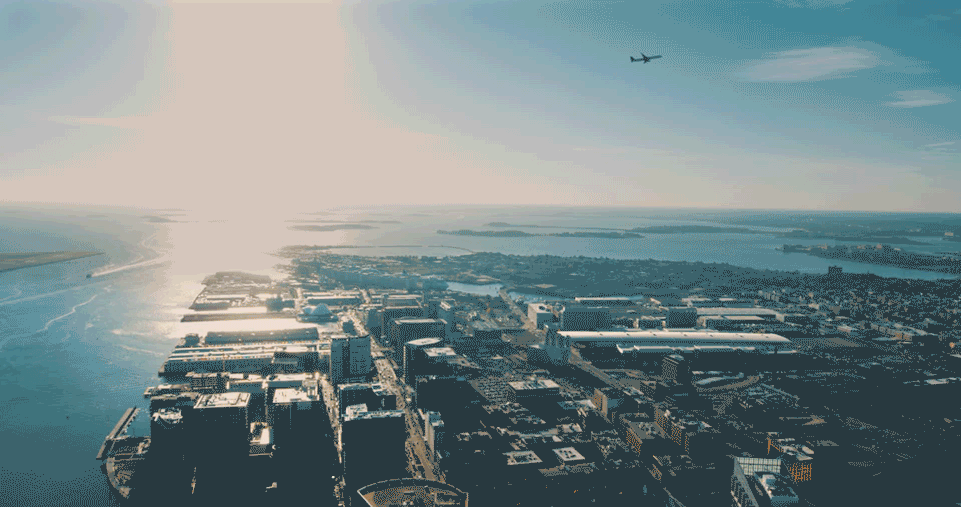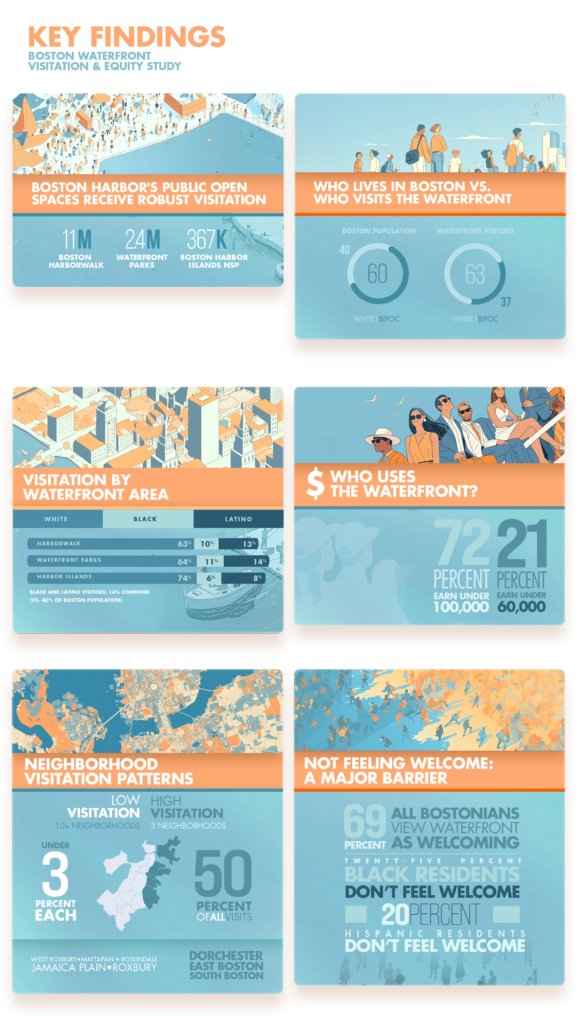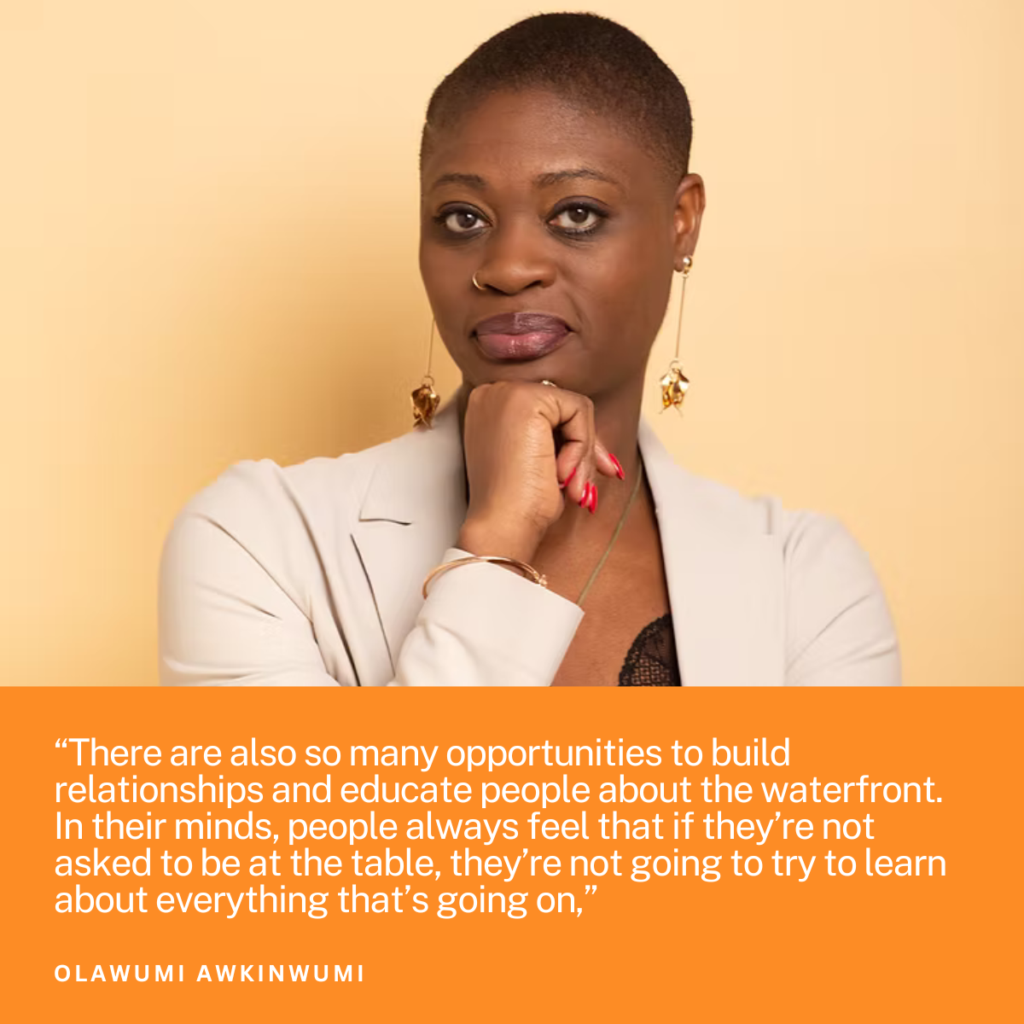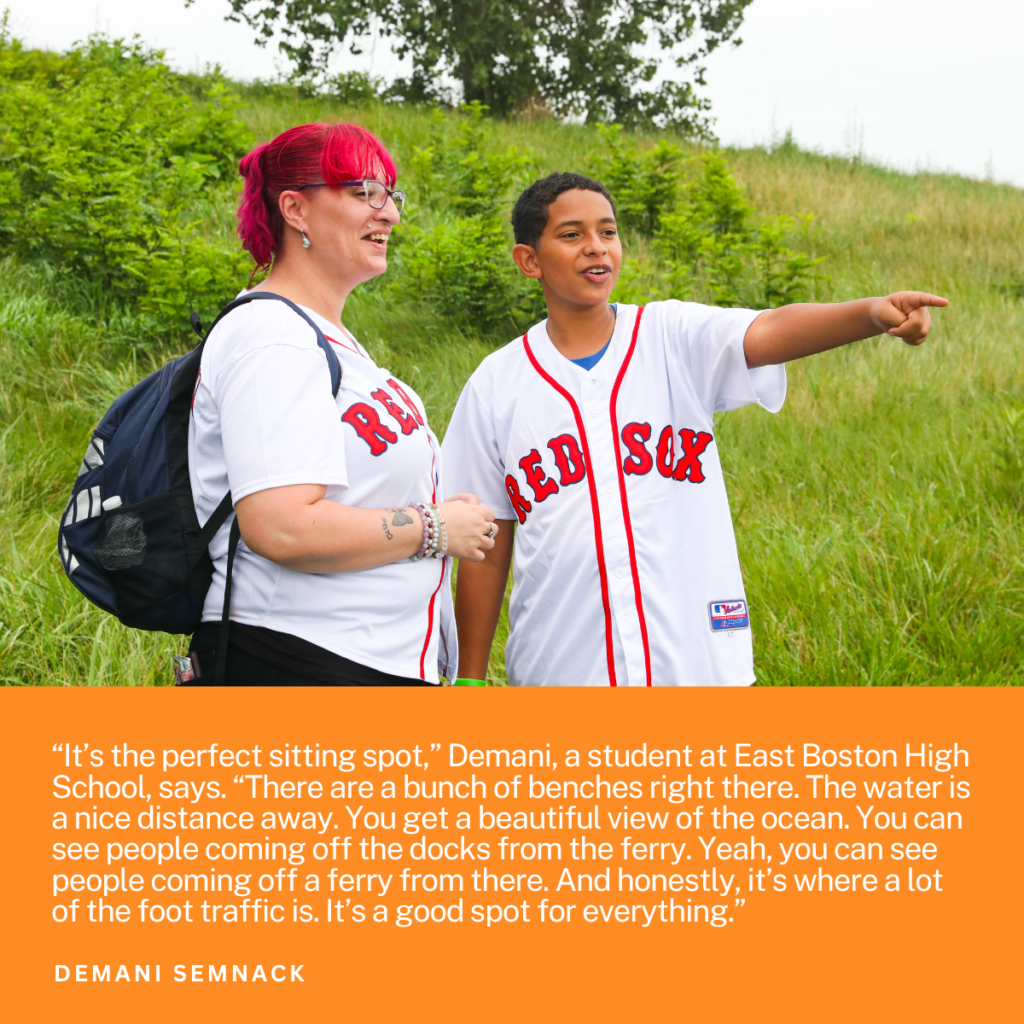Waterfront Visitation and Equity Study
A groundbreaking analysis of who visits Boston’s waterfront and who is left out.

Overview
For the first time, Boston now has a clear picture of how many people visit its public waterfront, who they are, and who is missing its benefits. The Waterfront Visitation and Equity Study draws on four years of statewide mobility data, 1,550 in-person surveys, dozens of community voices, and decades of journalistic records to answer a simple but elusive question: Who benefits from Boston Harbor’s public open spaces?
The results show that while Boston Harbor, waterfront parks, and Harborwalk trails enjoy robust use and welcome tens of millions of visits annually, access and belonging are not equally shared. The goal of this study is to provide tools, insights, and practices that help stakeholders direct efforts and investments so these waterfront spaces are places of joy, health, resilience, and connection for all.

Background
Boston Harbor has undergone a dramatic transformation over the last half century, from pollution and exclusion to cleaner waters and iconic public spaces. But history still casts shadows:
- Communities of color and many neighborhoods remain underrepresented in waterfront visitation.
- Generational stories and past racial violence continue to shape who feels welcome.
- Despite billions in public investment, many residents and visitors do not yet see the waterfront as theirs.
Boston Harbor Now launched this multi-year study to uncover some of those barriers and the opportunities to make the waterfront better.

The Study
“Boston’s waterfront belongs to every neighborhood and everyone should feel connected to our most treasured asset. The data in this study is crucial to ensuring we continue breaking down barriers to our Harbor whether they be transportation, affordability, or belonging. From East Boston down to Dorchester and beyond, this work is about ensuring that Boston’s shoreline is a place of inclusion, resilience, and shared ownership for generations to come.”
– Gabriela “Gigi” Coletta Zapata, Boston City Councilor District 1
The Waterfront Visitation and Equity Study is the first of its kind for Boston Harbor. For decades, we have known Boston Harbor plays a central role in the well-being of our region. Until now, no one had the full picture of who uses these spaces and who does not. This study breaks new ground by analyzing mobility data at a scale never before applied to Boston’s waterfront.
To ensure accuracy, Boston Harbor Now paired this analysis with a rigorous validation substudy led by the MassINC Polling Group, a level of practice more often seen at academic and research institutions. Just as importantly, we are making the underlying data open and accessible through GitHub so others can learn from and build on this work. The result is a data-driven, community-informed understanding of Boston Harbor that sets a new standard for how public spaces can be studied and improved to address equity gaps.
This study has been featured at the 2024 Boston Area Research Initiative Conference, 2024 City Parks Alliance Greater and Greener Conference, and the National Recreation and Parks Association 2024 Annual Conference Atlanta.
Key Findings

Project Resources & Open Data
Study Reports & Summaries
- Official Media Release (PDF)
- Boston Harbor For All: Report Executive Summary (PDF)
- Study Fact Sheet (PDF)
Validation & Ground-Truthing Studies
Technical Data Analysis
- Waterfront Data Project Phase 1 Report – Preliminary Review of Datasets (PDF)
- Waterfront Data Project: Ground-truthing Follow-Up – Interrelaterability Assessment (PDF)
- Waterfront Data Project: Query Summary – Visitation Queries Analysis (PDF)
Open Data & Code
Data Privacy and Ethics
This study was designed to understand patterns of visitation to Boston’s public waterfront without identifying or tracking individuals. The FAQs below explain what data was used, how privacy was protected, and how the findings will be used.
Boston Harbor Now values privacy. The Waterfront Visitation and Equity Study was designed to understand how people use and experience Boston’s public waterfront spaces without identifying or tracking individuals. Protecting privacy was a priority in every stage of this project.
- Aggregated mobility data from Veraset (2019–2022) was used to analyze visitation trends across Boston Harbor public spaces, including waterfront parks, the Boston Harborwalk, and the Boston Harbor Islands.
- The dataset reflects anonymized and de-identified non-personally identifiable mobile device location signals. These represent patterns of visitation, not individual people.
- Data was analyzed at the census tract or neighborhood level, never at the individual device level.
- All personal identifiers were removed before Boston Harbor Now accessed the dataset.
- Researchers followed industry standard privacy and data governance protocols.
- The study approach met or exceeded CCPA and GDPR guidelines for anonymized mobility data.
- Findings are presented only as aggregated results, such as “visits from Dorchester” or “visits to Spectacle Island” in weekly or annual totals, with no traceable personal information.
- No behavioral profiling, re-identification, or marketing use of data occurred.
- Raw data chain of custody stayed between Tectonix and Veraset, firms that specialize in secure, anonymized mobility insights.
- Ground truth validation was conducted by the MassINC Polling Group, which collected survey data in parks to confirm that model results matched real-world visitation patterns. No personally identifiable information was collected during surveying.
- Boston Harbor Now senior staff and the project’s Steering Committee conducted governance and ethics reviews that guided decisions on data scope and privacy protections.
The Waterfront Visitation and Equity Study is a public resource to help planners, policymakers, park partners, and advocates create a more welcoming and equitable waterfront. The study does not collect or share personal information. All outputs are designed to support public benefit, transparency, and better decision making about access and investment along Boston Harbor.
Project Partners
The Waterfront Visitation and Equity Study was made possible through the collaboration of technology, data, and research partners, funders, and community organizations. Key financial support from the Barr Foundation and an anonymous foundation, along with guidance from a steering committee of nonprofit and community leaders, ensured the study reflects both rigorous analysis and the lived experiences of Boston’s waterfront communities.
Project Steering Committee
The Waterfront Visitation and Equity Study was shaped and guided by a Project Steering Committee made up of partners from government, nonprofit, academic, and community organizations. This group helped ensure that the study remained transparent, inclusive, and rooted in lived experience. Their insights and feedback informed every stage of the process, from how data was collected to how findings were interpreted. Together, they helped make this work a trusted and collaborative effort to better understand who visits Boston’s waterfront and who is still left out.
Charles River Watershed Association
City of Boston Office of Climate Resilience
City of Boston Parks and Recreation Department
Coalition for a Resilient and Inclusive Waterfront
Harborfront Neighborhood Alliance
Massachusetts Department of Conservation and Recreation
Mystic River Watershed Association
Neponset River Watershed Association
Rose Kennedy Greenway Conservancy
State Senator Lydia Edwards’ Office
Writing & Design

Co-written by Alyssa Haywoode, who transformed hundreds of data points and voices into a clear and engaging story.

Report art direction by Ralph Moreau, who made the pages of the report legible and beautiful.
Community Voices
We are especially grateful to the people who shared their stories and perspectives: Kathy Abbott, Keeta and Sophia Robinson, Nikki and Demani Semnack, Veronica Robles, Olawumi Akinwumi, Bud Ris, and John Connors.




Research Guidance & Analysis
- Ford Fishman, our “data whisperer,” who translated digital footprints into human insights.
- Nishant Kishore, Ph.D., our academic compass, who kept us rigorous and curious.
- Luc Schuster, Boston Indicators Project, for inspiring us to take on the hardest questions.
Technology & Fieldwork
- Elliott Bradshaw and Mike DiMarco, Tectonix, for groundbreaking technology and a leap of faith.
- MassINC Polling Group, for spending long summer days in Boston’s parks to create a validation dataset.
Project Funders
This project was made possible through the generosity of Jill Valdes Horwood and the Barr Foundation, and a foundation that prefers to remain anonymous but deserves loud and public gratitude nonetheless.
Upcoming Events
Boston Harbor For All: Advancing Equity, Access, and Community Well-Being

Turning data, stories, and policies into impact
Please join Boston Harbor Now and the Coalition for a Resilient and Inclusive Waterfront for a half-day summit exploring the findings of the Waterfront Visitation and Equity Study. The event brings together 300 advocates, planners, community members, and policymakers, to discuss access, identity, and belonging along Boston’s waterfront.
We will look at how different communities experience the waterfront, how transportation and design shape access, how climate resilience intersects with equity, and how data can guide meaningful action. This summit also launches CRIW’s 2026 Wellness Weekend series.
Location: MGH Institute of Health Professions, 1 Constitution Wharf, Charlestown
Date: April 2026
Be part of the change!
Join our early access list below to be the first to know when everything goes live.

